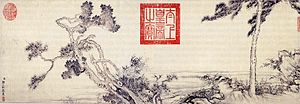Zou Yigui
Wygląd

| Nazwisko chińskie | |||||||||
|---|---|---|---|---|---|---|---|---|---|
| |||||||||
Zou Yigui (ur. 1686, zm. 1772[1]) – malarz chiński z czasów dynastii Qing.
Pochodził z Wuxi w prowincji Jiangsu[2]. Tworzył jako malarz nadworny[3]. Tematem jego obrazów były kwiaty i pejzaże[4]. Pozostawił po sobie traktat teoretyczny Xiaoshan huapu (小山画谱), poświęcony sztuce malowania kwiatów[5].
Był zaciekłym krytykiem popularnego na dworze cesarskim malarstwa europejskiego, które uważał za zbyt realistyczne[6]. Jego twórców miał jedynie za prostych wyrobników, a nie artystów[7].
Przypisy
[edytuj | edytuj kod]- ↑ Anne Farrer: The Brush dances & the ink sings: Chinese paintings and calligraphy from the British Museum. London: South Bank Centre, 1990, s. 132. ISBN 978-1-85332-058-3.
- ↑ Weichao Yu: A Journey Into China's Antiquity: Yuan Dynasty, Ming Dynasty, Qing Dynasty. Beijing: Morning Glory Publishers, 1997, s. 287. ISBN 978-7-5054-0514-1.
- ↑ Anita Chung: Drawing boundaries: architectural images in Qing China. Honolulu: University of Hawai'i Press, 2004, s. 63. ISBN 0-8248-2663-9.
- ↑ Mark Elvin: The Retreat of the Elephants: An Environmental History of China. New Haven, Connecticut: Yale University Press, 2004, s. 233. ISBN 978-0-300-11993-0.
- ↑ Xiaoxin Wu: Encounters and dialogues: changing perspectives on Chinese-Western exchanges from the sixteenth to eighteenth centuries. San Francisco: Monumenta Serica Institute, 2005, s. 249. ISBN 978-3-8050-0525-8.
- ↑ Helaine Selin: Encyclopaedia of the history of science, technology, and medicine in non-western cultures. Dordrecht; Boston: Springer, 1997, s. 314. ISBN 0-7923-4066-3.
- ↑ Paul van der Grijp: Art and exoticism: an anthropology of the yearning for authenticity. Berlin: LIT Verlag Münster, 1997, s. 194. ISBN 978-3-8258-1667-4.